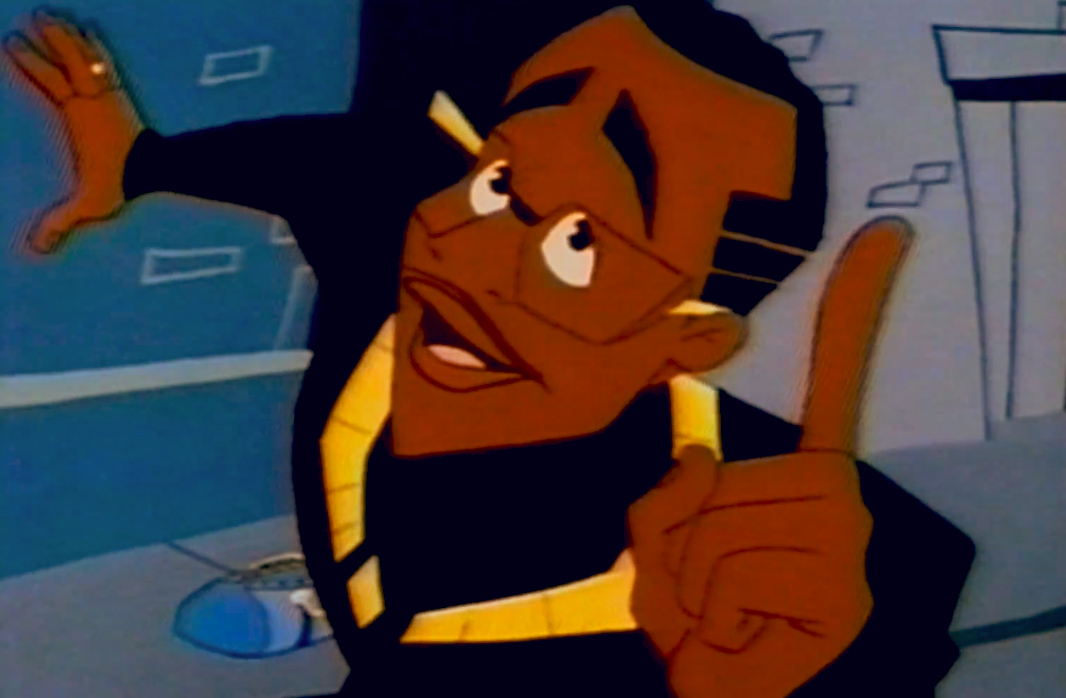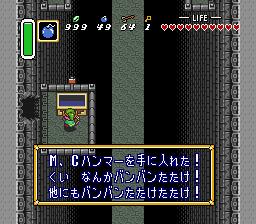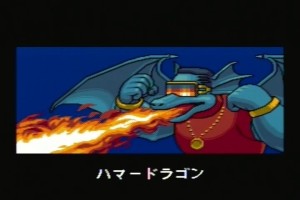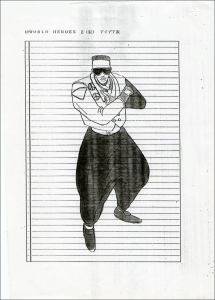The late 80s and early 90s are riddled with stories of meteoric rises to stardom and falls from grace, but perhaps none burned out quite as spectacularly (and publicly) as M.C. Hammer. We often forget just how much of A Big Deal Hammer and Vanilla Ice and other 90s musicians/groups were1. Honestly, I’m not sure if even modern social media powered bands like One Direction come close to just how visible, overblown, and heavily merchandised Hammer and company were. We laugh at the ridiculous crap their faces were plastered upon now, but at the time, these guys defined coolness to young people.
Yes, MC Hammer had it all in the early 90s: mansions, racehorses, a vanity Saturday morning cartoon series, and the admiration of millions, yet numerous poor investment decisions, a taste for expensive theatrics, and constantly overextending himself eventually bit him in the ass. I’m honestly surprised people didn’t see it coming at the time – watching the 2 Legit 2 Quit music video again, over 20 years after its debut, will rid you of any pity you might feel for his extravagant lifestyle and rapid crash really fast. The amount of sheer ego and hubris on display here is simply jawdropping.
One privilege that major English language recording artists have is that their stuff faces very few barriers to worldwide acceptance. Popular English music is inherently a global thing, just like Hollywood films, even in territories where English isn’t widely spoken. Such is the case with Japan as well, where audiences were equally taken by Hammer’s impressive dance moves, slick beats, and flashy performances. While his contemporary Vanilla Ice may have earned eternal infamy in Japan by becoming a nasty Jojo’s Bizarre Adventure villain with a prominent bulge, Hammer wound up getting tributes (and attempted tributes) in a handful of games, including an all-time classic.
The Legend of Zelda: A Link to the Past released in late 1991 in Japan, about the time MC Hammer’s popularity had begun to peak. Nintendo’s developers were evidently among those in the thrall of flashy sequined dance pants, as evidenced by the fact that they put a very obvious reference to the man in the game.
This item, known as the “Magic Hammer” in the English versions, is called the MC Hammer in the Japanese version of the game. The katakana used to render the item name is a bit odd – it’s written ハンマー(hanma-) rather than ハマー(hama-), the latter of which was used when transliterating the living, breathing MC Hammer’s name. Perhaps it was Nintendo’s way of trying to make the reference more “subtle,” but it doesn’t really work. No idea what the MC would stand for in Hyrule, either – Magic Crushing? Anyway, Clyde Mandelin wrote about this out-of-place reference (and an odd Vanilla Ice reference in another game) in a bit more detail over on his site, so go check it out.
Those of you who’ve watched my kusoge panel video saw that I touched a bit on the Mega CD game Wakusei Woodstock Funky Horror Band. I really wanted to go into that one a bit more, since it’s one of my “favorite” kusoge, but I ultimately cut a lot of discussion of it in the interest of time. Basically, the game’s plot is that a novelty band of aliens (who actually did get marketed outside of the game with CDs and such) crash-land on a fantasy planet where everything is a music reference and heaps of trouble are afoot. The enemies you fight normally (or, more frequently, run away from) tend to be painful music puns, i.e. treasure chest monsters named “Mimick Jagger,” headless knights called “Bob Dullahan,” and drink-carrying healers named “Juice Priest.”
One of the most notorious elements of the game is that two of its five chapters are completely unplayable – you just watch the sort motion-comic like cutscenes common on the PCE CD and Mega CD for a few minutes while a FHB song blares behind it. The second chapter features a “quest” to retrieve a healing herb from the realm of a “horrible dragon,” who looks like this:
Yep, the big threat in Chapter 2 is another MC Hammer reference, and just in case you don’t get it, they went as far as to name it “Hammer Dragon” in the subtitle. Basically, you just watch him stomp around a bit before he goes down like a chump. Rap falls to the power of sweet guitar riffs in the FHB universe, it seems.
Hammer Dragon does eventually get a real fight, however, as part of an endgame boss re-fight gauntlet. That particular sprite, ironically, has more animation than he does in the whole chapter 2 cinematic.
You can watch the whole of FHB Chapter 2 (all three minutes of it) here on Nico Nico Douga.
Believe it or not, we also came extremely close to having Hammer’s inspiration touch the weird and wonderful world of fighting games. Not long ago, my pal John Anderson (who you should definitely follow if you love retro gaming ephemera) posted a link to a Japanese page with a whole mess of official ADK company material. There’s even a few design documents and proposals in the mix, including the pitch for World Heroes 2. Said pitch included a few conceptual designs for new characters that went unused: Abis, an Egyptian pharaoh, Machua, a female Muay Thai fighter, and this guy:
This character is referred to in the material as “MC Fire,” and he’s a rapper from the Bronx who fights as the “New Generation King of Rap.” He’s a megahit entertainer whose first and second albums were worldwide hits, and now he’s off to show the world of combat he can be just as entertaining there, too! His moves are “speedy” and “dance-style,” and once concept shown is the Fire Steiner:
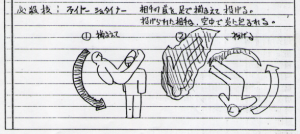 Alas, none of the characters in this initial proposal made the final cut2. While it’s certainly regretful that we didn’t see MC Fire come to fruition ingame as a representative of America’s entertainment industry, we did get Johnny Maximum, so it’s certainly not all bad.
Alas, none of the characters in this initial proposal made the final cut2. While it’s certainly regretful that we didn’t see MC Fire come to fruition ingame as a representative of America’s entertainment industry, we did get Johnny Maximum, so it’s certainly not all bad.
Tributes and parodies are well and good, of course, but something few people realize is that two honest-to-god official MC Hammer games also exist. Well, one of them does, anyway – the other almost existed, and may just be the among the most puzzling and intriguing cancelled games that we actually have video footage of.
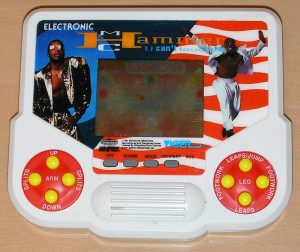 The first one is the Tiger handheld LCD game. There’s no footage of this game online – just pictures of the casing – but somehow the game’s instruction manual survives as a PDF! Apparently it’s a game about mimicking onscreen dance movies. Oh ho, I see where you got the concept for Dance Central now, Harmonix! It looks a fair bit more difficult than other LCD games of the time – hell, few of these Tiger Electronics games had more than four buttons. Unfortunately, it seems to be one of the rarer Tiger games (and I’m sure a bunch of copies got junked after Hammer became passe), so if you’re dying to play it it’s going to be quite a tough find. Given the overall quality of these games, you’re likely not missing much.
The first one is the Tiger handheld LCD game. There’s no footage of this game online – just pictures of the casing – but somehow the game’s instruction manual survives as a PDF! Apparently it’s a game about mimicking onscreen dance movies. Oh ho, I see where you got the concept for Dance Central now, Harmonix! It looks a fair bit more difficult than other LCD games of the time – hell, few of these Tiger Electronics games had more than four buttons. Unfortunately, it seems to be one of the rarer Tiger games (and I’m sure a bunch of copies got junked after Hammer became passe), so if you’re dying to play it it’s going to be quite a tough find. Given the overall quality of these games, you’re likely not missing much.
And then there’s this:
Now this game’s a real mystery. Titled Hammer vs. Evil D in Soulfire, this Sega CD game didn’t get any sort of preview coverage in magazines at the time – in fact, this is the only known media of the game known to exist. It’s a 17-second clip from a Sega CES demo video lineup. One of the former artists on the game wrote a bit about it, and even posted a few concept drawings and sprite art, but that’s basically all we have to go on.
In the blog entry, it’s mentioned that the game was conceived as a Double Dragon-esque beat-em-up, but the video doesn’t give any hints of that. Instead, it looks like a weird into-the-screen shooter, Nam 75 or Wild Guns style, with a dancing Hammer character and that signature compressed-to-hell Sega CD FMV running on a small window in the background while a music clip loops incessantly. There’s a number in the upper left that seems like it’d be a timer, but it fluctuates constantly for no discernible reason. Bizarre indeed!
So that’s it for MC Hammer’s brief but noteworthy gaming career – at least, what I know of. I get the feeling there are probably some some Hammer influenced games out there, particularly in more obscure Japanese offerings. If you know of any, put them in the comments so I can check them out. To conclude, I leave you with this:
- NKotB comes to mind, as well – we still haven’t found their NES game yet, but the prototype box has changed hands for a ridiculous sum. ↩
- Though a Muay Thai champ did eventually come to the series, it was a very different character design. ↩
